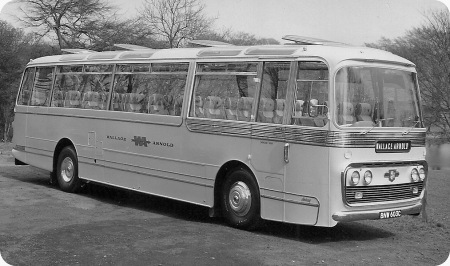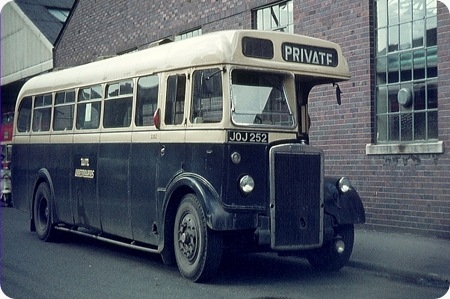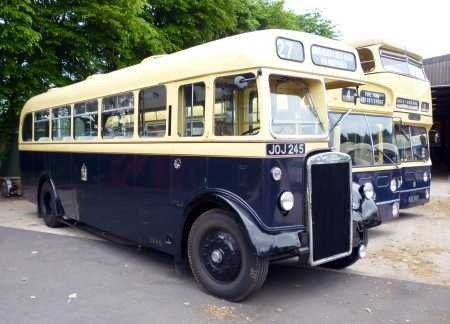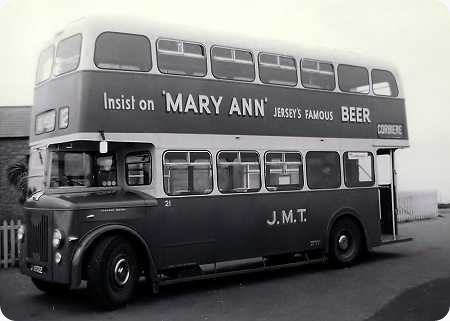Wallace Arnold Tours – Leyland Leopard – Plaxton – BNW 603C
Wallace Arnold Tours Leeds
1965
Leyland Leopard PSU3/3R
Plaxton Panorama C49C
BNW 603C was one of the 1965 batch of Leyland Leopards with WA’s specified centre-entrance Plaxton Panorama bodies. This is an official publicity photograph taken at Roundhay Park, Leeds immediately after delivery. Judging by the trees, it must have been taken in early April (it’s documented delivery month), and I suspect that the roof lights would soon have been closed after the photographs were taken. Perhaps this coach was to be entered in the 1965 Blackpool and Brighton Coach Rallies, so the non-standard chrome wheel trims would be retained until after the events, and then removed in favour of the standard red paint trim.
would be retained until after the events, and then removed in favour of the standard red paint trim.
As a final observation, why has this "Panorama" got the "Embassy" badge attached to the front off-side panel?
Photograph and Copy contributed by Paul Haywood
———
19/02/12 – 07:44
…..because it IS an Embassy and not a Panorama! The Panorama has fixed windows and forced air ventilation, The Embassy has (multiple) slider vents and no forced air ventilation. This, along with centre entrances, was a WA special specification for years.
There was a gradual move towards standard Plaxton specification during the sixties. This vehicle certainly has Panorama moldings and ribbed metal detail but it was only with the 1968 F registered vehicles that WA received standard Panoramas. [From 1967, Plaxton renamed and labelled the Panorama as Panorama I and the Embassy as Panorama II. To muddy the water even more, the Embassy on a Bedford VAL was originally called a Val and on a Bedford VAM a Vam!]
This was Plaxton emerging into it’s high point in history. Regrettably, wooden frames – common on all coach bodies – means that few coaches have survived into preservation compared with service buses.
David Oldfield
———
19/02/12 – 09:00
A most interesting feature Paul from our days at WA – I was unaware of all these finer details about Plaxton/WA specifications and trim. I’ve just hurried to my records and find that I never encountered this coach, but I did drive three others of the batch. I can well see the wisdom of removing the fancy wheel trims promptly, as the heavy Leopards were short on braking stamina as is well known, and any extra optional heat build up was not to be recommended.
Chris Youhill
———
19/02/12 – 14:06
BNW 603C was indeed WA’s entry in the 1965 Blackpool Coach Rally, driven by Eric Patrickson. They also entered BNW 633C, a Ford 676E/Duple C51F from the Feather fleet. But WA did not enter any coaches in the Brighton Rally.
Dave Williamson
———
19/02/12 – 16:44
One of this batch the number which is lost in the shadow of time was rebodied and reregistered by Stanley Gath Coaches of Dewsbury. Perhaps someone remembers its new identity.
Philip Carlton
———
19/02/12 – 16:47
Whoops!
You’re right, David, muddy waters indeed, and I’m sure you are technically correct in what you say. However, to me – if they have panoramic windows, they are Panoramas.
The last of the "official" WA Embassys in 1962, albeit stretched to 36ft, had small windows and a bulbous front and rear – totally unlike a Panorama. I now discover that WA’s 1963 and 64 intake of coaches with Panorama-like bodies were also badged as Embassys.
What is even more strange is that, according to Plaxton history, the Embassy style was designed for lightweight chassis, even though the lightweight VAMs and VALs of the same period had "official" Panorama bodies!
Thankfully, common sense seemed to prevail and the name Panorama-1 became universal for this style of bodywork, albeit with a front-entrance.
Beam me up, Scottie!
Paul Haywood
———
…..and talking of special WA specifications…..
Woodgrain veneer/formica was the normal finish on both Duples and Plaxtons in the ’60s – which got darker and darker as the decade progressed. The exceptions were these self same WA centre entrance specials which had a very light non standard finish. I never rode on any but "observed" many on holidays in Devon and Cornwall. My hazy memory recalls a light greeny/grey hue with sunshine motifs – but whatever it was, it was unique to WA.
David Oldfield
———
20/02/12 – 09:05
The point is that from the 1963 season onwards, ALL 36-foot Plaxton bodies had long windows, but not all 36-foot Plaxton bodies were Panoramas. All the evidence says that until the introduction of the Panorama II, the Panorama was fiercely protected as a premium product by the application of three rules: it must have fixed windows, it must have a front entrance and it must be on a heavyweight chassis.
Peter Williamson
———
20/02/12 – 09:06
It’s strange how the space where the air scoop would have been doesn’t have a glazed quarterlight. Obviously it’s a coach which could be more than adequately ventilated, the trouble was, even on the coldest of days, there was always someone who wanted a window open! With regard to the name, don’t forget the Venturer appeared in several different forms but was it still the Venturer? The Embassys which Paul mentions with the bulbous front had a wonderful stately air about them (when fitted to underfloor engined chassis) the aristocrats of the road!
Chris Barker
———
21/02/12 – 07:20
Many Plaxton coaches of the 50s and early 60s appeared in three different forms at the same time, quite apart from variations year on year. These were:
1. underfloor engined with centre entrance (bulbous front)
2. underfloor engined with front entrance (flat front)
3. front engined with entrance behind front wheel.
There were cases where these different versions had different windscreens and/or grilles, and once the Panorama got added to the mix, it took dedicated study to work out what was what.
Peter Williamson
———
26/02/12 – 07:24
Having just seen a couple of photos of 1965 Bedford SBs with Panorama bodies (of the type later badged as Panorama I), I must modify slightly something I said above: it seems that the embargo on "lightweight" Panoramas was lifted with the Ogle restyling for the 1965 coaching season.
Peter Williamson
Quick links to the - Comments Page - Contact Page - Home Page




